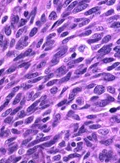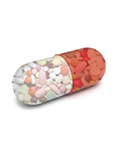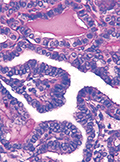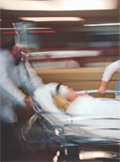The eLitMed.hu medical portal uses computer cookies for convenient operation. Detailed information can be found in the Cookie-policy.
Lege Artis Medicinae - 2015;25(03)
Content
[Protection of gastrointestinal system in cardiovascular diseases]
[Cardiovascular preventive drugs (nonsteroidal antiinflammatory drugs, aspirin, inhibitors of platelet aggregation, anticoagulants) are among the most frequently used medicines all over the world. Gastrointestinal (GI) complications (hemorrhage, ulceration, perphoration) are among the most frequent side effects of these drugs, however, differences in their pharmacodynamics properties and other pleiotropic effects may substantially modify these unwanted events. Authors, based on international and Hungarian guidelines, summarize the most important data for GI protection, focusing on the use of H-2 receptor blockers and proton pump inhibitors.]
[The role of hypoxia in tissue regeneration and in development of amplified aggressive fenotypes in malignant cancer]
[Several diseases are accompanied by hypoxic stress; elimination of it is an important physiological process. Our body provides a protective function which delays damage and destruction by hypoxia. In case of necrosis, it provides the mop up of the damaged area. This security system starts the regeneration in cells of the hypoxic zone which surrounds the necrotic area, resulting in the survival of the cells in hypoxic environment and ensuring the handling of the necrosis. The key molecules of the system are the hypoxia-induced factor molecules. The review discusses the physiological role of tissue hypoxia and normoxia and its effects on tissue regeneration. The physiological system triggered by the hypoxia-induced factor plays an important role in embryonic development, in wound healing and in numerous diseases (eg. myocardial infarction, stroke, vaculities, etc). Unfortunately, this system also plays a key role in several malignant tumors by rising the development of cells with increased aggressive fenotypes as well. The physiological process of regeneration starts in the hypoxic tumor cells aided by the hypoxia-induced factor system. The process results in neovascularization, and in the case of tissue damage, in the mop up of the necrotic tissue and in the restoration of tissue oxygenisation. However, after the formation of the new vascular network, tumor cells accustomed to hypoxia will not die but keep their original uncontrolled proliferation and anaerobic nature. Moreover the malignant nature of the cells will be increased by the genetic changes generated by the system of hypoxia- induced factors. The role of the hypoxia-induced factor system in tumor progression is discussed by the example of one of the most malignant tumors, malignant melanoma.]
[Biosimilar insulins on the horizon]
[Nowadays human insulins and insulin analogues are exclusively used in the clinical practice, when insulin therapy is needed. The patents of human insulins are expired and will expire soon for glargine, the first long-acting, basal insulin analogue preparation. The reliable production of biosimilar insulins is a new challenge for the pharmaceutical industry. Independently developed insulins with appreciable clinical efficacy have already become available in some countries where the quality criteria of regulatory process in place are less strict than in the European Union. The first approval for true biosimilar insulin, i.e. for biosimilar glargine was given in Europe in 2014. In this article, the characteristics of biosimilar insulins, especially the difficulties in the manufacturing process are reviewed in comparison with generic drugs. It is of note that potential efficacy and safety differences may occur due to even minor changes in the production, formulation and storage of the biological drugs. Therefore, biosimilarity should be investigated by detailed comparative pharmacokinetic and pharmacodynamic studies. Moreover, similar clinical efficacy and safety should be documented by randomized, comparative clinical trials. The potential impact of altered immunologic profile of biosimilar insulins should also be carefully monitored. ]
[Experiences with fix combination of amlodipin-atorvastatin according to the ESH/ESC hypertension recommendation 2013]
[BACKGROUND - Hypertension is a widespread disease in Hungary and worldwide as well. Combination products containing more effective agents in one pill have an increasing role in the treatment strategy. One of the most often used products is Amlator, in which the advantageous features of amlodipine and atorvastatin are combined. METHOD - During my investigation I treated a patient with just diagnosed hypertension, prescribing Amlator 20/5 pill once a day. Blood pressure measurements were registered at home in a blood pressure diary. After two months laboratory and ABPM measurements were administered again. Gathered data was compared and changes were analysed. RESULTS - During the first ABPM measurement the mean blood pressure was 150/90 mmHg. Laboratory measurements showed a moderate increase in cholesterol level (6.1 mmol/l), lipid values were in the normal range (LDL 3.0 mmol/l, HDL 2.61 mmol/l) and hypertriglyceridemia wasn’t observed either (0.97 mmol/l). The blood pressures measured at home showed a significant decrease using the prescribed medication. During the first month the average blood pressure was 133/80 mmHg. This shows an 11.3% decrease of the systolic value. At the second monthly inspection a decrease in the cholesterol level was noted (cholesterol 5.0 mmol/l, LDL 2.31 mmol/l, HDL 2.2 mmol/l, triglyceride 0.96 mmol/l). This is a 14.7% decrease. The second ABPM measurement showed a significant decrease in both the systolic and diastolic blood pressure values. The average blood pressure was 124/78 mmHg, which means a 17.3% decrease of the systolic value. CONCLUSION - Amlator proved to be an effective treatment of both hypertension and hypercholesterolemia.]
[The real cost of caring for seriously ill patients - compassion fatigue or satisfaction]
[The improvement of the Hungarian hospice network and the increasing number of people dealing with the seriously ill are reflected by the annual hospice reports (2001-2013). However these reports also draw the attention to the cumulating mental and spiritual burdens of carers which can lead to fatigue and burnout. On the base of practical experience we surveyed the mental and spiritual condition of the caregivers of seriously ill patients and also reviewed research findings and the professional literature on the exposure to imperilment. The grounds of professional literature’s research were the Hungarian and international databases. We favoured studies published in Hungarian or English between 2000 and 2014 primarily on carers working in palliative and hospice service. One of the main profits of reviewing the professional literature is getting more detailed information on the mental state of professional caregivers. Relatively new element in researches is studying the relation between burnout and compassion satisfaction and compassion fatigue. It includes studying of symptoms and coping strategies. These all enable a better understanding of causes and help us to support hospice carers with more effective methods to protect them from mental and spiritual exhaustion.]
[Illness representation of patiens with migraine and tension headache]
[It’s been proven by many scientific observation that patients describe their diseases both in progression and adaptation in a different manner even though having a similar origin. The reason behind is the various cognitive background. The investigation of this cognitive function may help us understand patients personal reactions better. In 2007 I investigated the effect of three factors (type, understanding and duration of the disease) on illness representation in patients suffering from headache. The patients included were the following three groups: having migraine with aura, migraine without aura and patients with tension headache. I was looking for correlations and differences in disease representations. For this investigation I have used illness representation questionnaires translated and adapted to Hungarian population. The data were obtained in the waiting hall of two headache centres in Debrecen. Although there were no significant correlations in most of the cases, certain tendencies were observed. Understanding of disease representation could be very useful tool in psychological support, psychotherapy for the patients and it could improve their quality of life.]
1.
Clinical Neuroscience
[Headache registry in Szeged: Experiences regarding to migraine patients]2.
Clinical Neuroscience
[The new target population of stroke awareness campaign: Kindergarten students ]3.
Clinical Neuroscience
Is there any difference in mortality rates of atrial fibrillation detected before or after ischemic stroke?4.
Clinical Neuroscience
Factors influencing the level of stigma in Parkinson’s disease in western Turkey5.
Clinical Neuroscience
[The effects of demographic and clinical factors on the severity of poststroke aphasia]1.
2.
Clinical Oncology
[Pancreatic cancer: ESMO Clinical Practice Guideline for diagnosis, treatment and follow-up]3.
Clinical Oncology
[Pharmacovigilance landscape – Lessons from the past and opportunities for future]4.
5.














